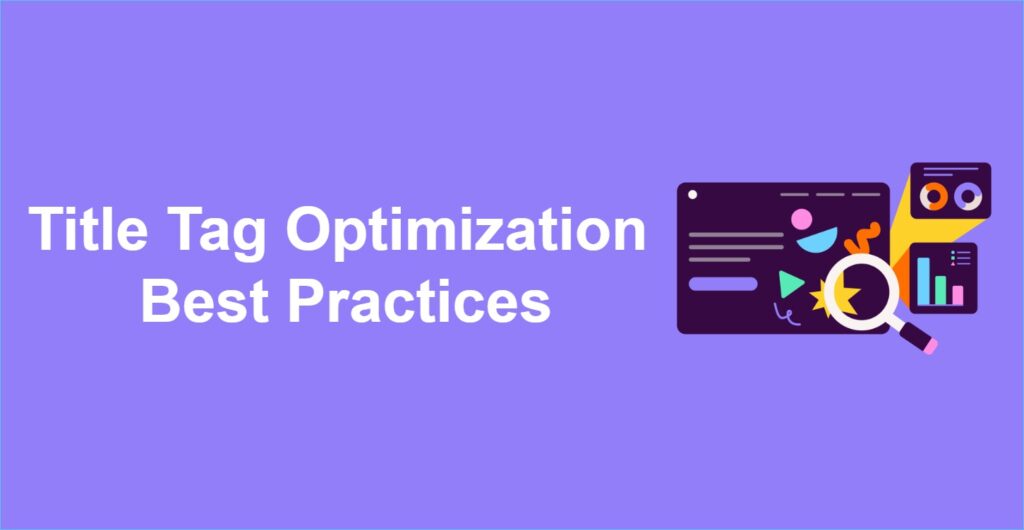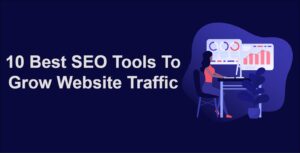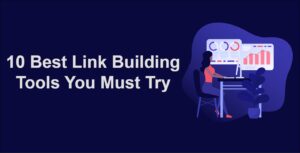In the dynamic landscape of search engine optimization (SEO), every element on a webpage plays a crucial role in determining its visibility and ranking on search engine results pages (SERPs). One of these critical elements is the title tag.
A well-optimized title tag can significantly impact your website’s SEO performance, making it essential to understand the best practices for optimizing title tags. In this comprehensive guide, we’ll explore the significance of title tag optimization, delve into the best practices, and provide insights on how to enhance your website’s SEO performance through effective title tag optimization.
Title tag optimization is a critical aspect of SEO that can significantly impact your website’s search visibility and user engagement. By following best practices and tailoring your title tags to different scenarios, you can enhance your website’s performance and attract more organic traffic.
Title tags are not only for search engines but also for users, so prioritize creating engaging and informative titles that encourage users to click through and explore your content.
What Is a SEO Title Tag?
The title tag, also known as the meta title or HTML title, is the main title that appears in search engine results and web browser tabs when a user visits a webpage. It serves as a concise and informative description of the page’s content and gives users and search engines a preview of what the page offers. Here’s why title tag optimization matters:
Search Optimization Title Tag
Title tags are pivotal in search engine optimization (SEO) by serving as concise and descriptive summaries of web page content. When a page is opened, a title tag appears as the clickable headline in search engine results and in browser tabs. Optimizing title tags enhances visibility, click-through rates, and overall search ranking.
1. Improved Click-Through Rates
A well-crafted title tag can entice users to click on your link in the search results. When the title accurately reflects the content of the page and appeals to user intent, it increases the likelihood of users clicking through to your website.
2. Enhanced Search Visibility
Search engines use the title tag as a primary factor to determine the relevance of a webpage to a user’s query. Optimizing the title tag with relevant keywords can improve your website’s chances of ranking higher in search results.
3. Branding and Consistency
The title tag is an opportunity to reinforce your brand and establish consistency across your website. A consistent format for title tags can help users recognize your content and increase brand recall.
4. Clear Content Preview
A well-crafted title tag provides users with a clear idea of what to expect when they visit your page. This reduces bounce rates and ensures that visitors are more likely to engage with your content.
How Search Engines Use Title Tags
Title tags are crucial elements in SEO, serving multiple purposes that impact both search engine rankings and user experience. Here’s an overview of how search engines utilize title tags based on the provided information.
Definition and Purpose
A title tag is an HTML element that defines the title of a webpage. It appears in the browser tab and is prominently displayed as the clickable headline in search engine results pages (SERPs). The primary functions of title tags include:
- Describing Page Content: Title tags provide a concise summary of what users can expect from the page, helping both search engines and users understand its relevance to their queries.
- Influencing Click-Through Rates (CTR): A well-crafted title tag can entice users to click on a search result, significantly impacting traffic to the website.
Importance for SEO
Title tags play a vital role in SEO for several reasons:
- Ranking Signals: Search engines like Google use title tags to determine the content and relevance of a webpage. Including relevant keywords in the title helps improve rankings for those terms. For instance, if a title tag contains the phrase “peach cobbler recipe,” it signals to search engines that the page is relevant for searches related to that term
- Search Result Display: Title tags are typically displayed as the main clickable link in SERPs. If the title is compelling and accurately reflects the content, it can lead to higher CTRs
- .Unique Identification: Each page should have a unique title tag that accurately reflects its specific content. Duplicate titles can confuse search engines and users, potentially leading to lower rankings
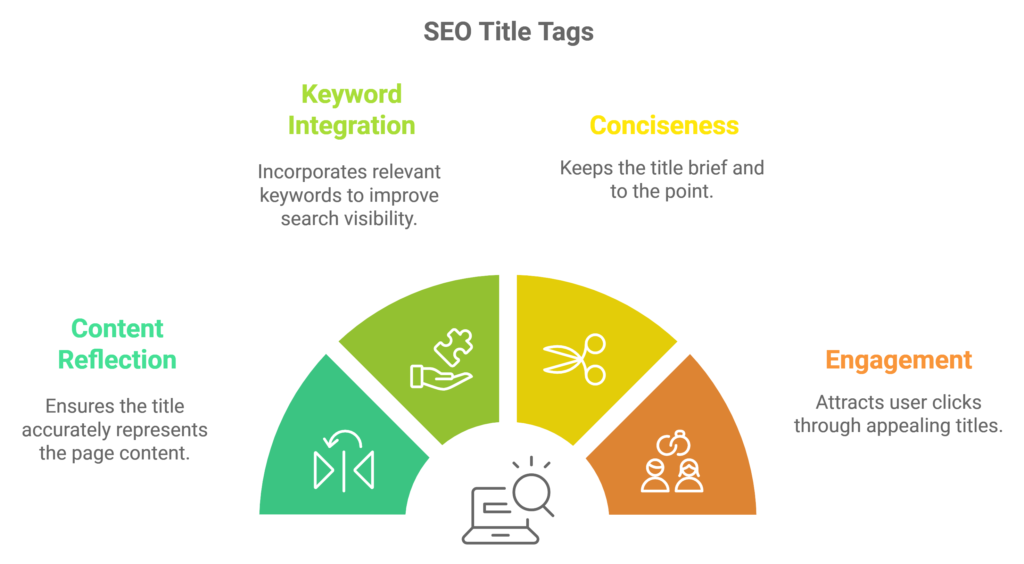
Best Practices for Title Tag Optimization
Effective title tag optimization involves a combination of strategic keyword placement, readability, and engaging content description. Here are the best practices to follow:
Best practices for optimizing title tags for SEO involve crafting concise and relevant titles that incorporate target keywords naturally. These strategies improve search engine ranking and click-through rates, driving organic traffic. Explore how to optimize title tags effectively for SEO success.
Here are the Best Practices for Title Tag Optimization
1. Use Relevant Keywords
Research and identify relevant keywords that align with the content of your page and match user intent. Include primary and secondary keywords that accurately reflect the topic.
2. Keep it Concise
Title tags should ideally be between 50 to 60 characters to ensure they display properly in search results. Keep your message concise while conveying the essence of your content.
3. Create Unique Titles
Avoid using duplicate title tags across multiple pages. Each page should have a unique and descriptive title that distinguishes it from others. Keeping titles under 70 characters is essential
4. Prioritize User Intent
Craft title tags that align with user intent. Think about what users are searching for and how your page fulfills their needs. A relevant title tag improves click-through rates.
5. Place Keywords at the Beginning
Whenever possible, include your primary keyword at the beginning of the title tag. This places emphasis on the main topic and improves search engine visibility.
6. Write for Humans
While optimization is important, title tags are ultimately meant for human users. Ensure your title tag is engaging, informative, and provides a clear preview of your content.
7. Avoid Keyword Stuffing
While it’s important to include keywords, avoid overloading your title tag with excessive keywords. This can appear spammy and harm your SEO efforts.
8. Consider Branding
Incorporate your brand name into the title tag, especially for homepage and key landing pages. This helps users recognize your content and build brand awareness.
9. Test and Monitor Performance
Regularly analyze the performance of your title tags using tools like Google Search Console or third-party SEO tools. Adjust and refine your title tags based on performance data.
How do you write a title tag for SEO?
Writing an effective title tag for SEO is a crucial aspect of on-page optimization. A well-crafted title tag informs search engines about your page’s content and entices users to click on your link in search results.
Title tags are essential for both SEO and user engagement. They’re often the first impression users have of your page, so crafting them thoughtfully is crucial in driving organic traffic and improving click-through rates.
Here’s how to create a compelling title tag:
1. Be Descriptive: Your title should accurately describe the content of your page. For example, if your page is about “Healthy Vegan Recipes,” your title might be: “Delicious and Nutritious Vegan Recipes for a Healthier You.”
2. Use Keywords: Include relevant keywords that users might use when searching for your content. For a vegan recipe website, consider using keywords like “vegan recipes” or “plant-based meals.”
3. Keep it Concise: Google typically displays a title tag’s first 50-60 characters in search results. Make sure your title is concise and to the point. For example, “Quick Vegan Dinner Recipes.”
4. Be Unique: Each page should have a unique title tag. Avoid duplicate titles, as this can confuse both users and search engines.
5. Engage the Audience: Craft titles that pique interest or offer solutions. For instance, “Simplify Weeknight Cooking with Easy Vegan Recipes.”
6. Front-Load Keywords: Place essential keywords near the beginning of your title for better visibility in search results.
7. Branding: If applicable, include your brand name at the end of the title, like “Easy Vegan Recipes | GreenLife Kitchen.

Writing Title Tags for Different Scenarios
Different types of webpages require varying approaches to title tag optimization. Here’s how to optimize title tags for different scenarios:
1. Homepage
For your website’s homepage, focus on creating a title tag that reflects your brand and provides a general overview of your business or services. Include your brand name and a concise description of your offerings.
2. Product or Service Pages
When optimizing title tags for product or service pages, include specific keywords that describe the product or service and highlight its benefits. Incorporate relevant features and unique selling points.
3. Blog Posts
For blog posts, craft title tags that accurately represent the topic of the post. Use compelling language to engage readers and convey the value they’ll gain from reading the post.
4. Location-Based Pages
If your business has physical locations, optimize title tags for location-based pages by including the city or region you serve. This helps attract local search traffic.
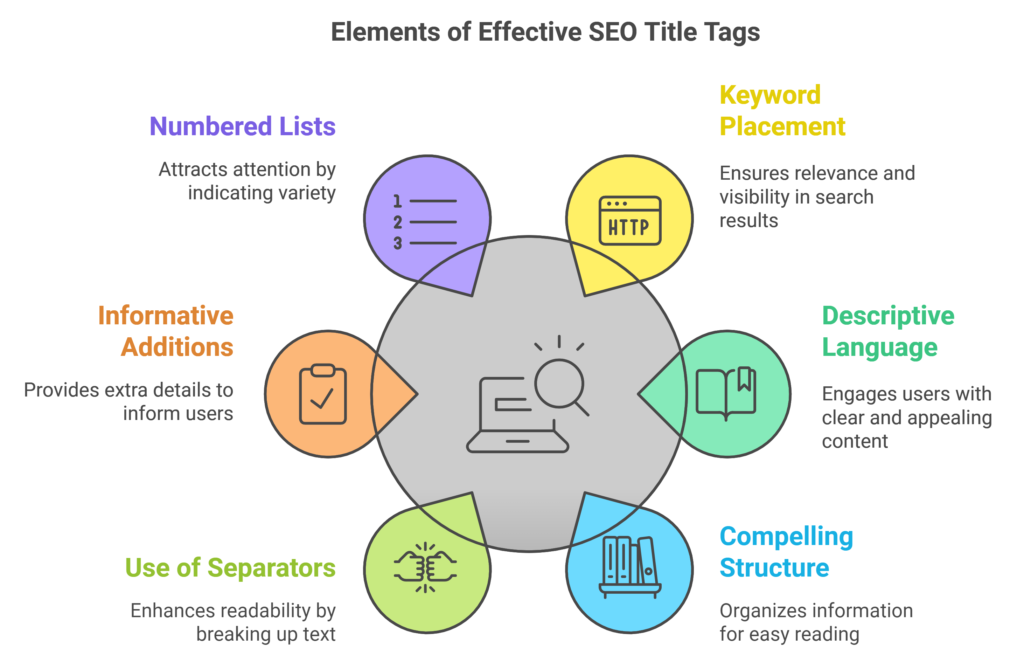
Case Studies That Illustrate the Impact of Title Tags on SEO
Here are five case studies that illustrate the impact of title tags on SEO performance and user engagement:
1. Moz Case Study: Title Tag Rewrites
Moz conducted an in-depth analysis of over 50,000 title tags to understand how Google rewrites them. They identified common issues such as repetitive branding and poorly structured titles. By updating their title tags to eliminate redundancy and improve clarity, they successfully reduced the number of bad rewrites.
Results:
- Improved clarity and relevance of titles led to better rankings.
- Enhanced click-through rates (CTR) due to more appealing and accurate titles.
2. TrustRadius Case Study: Title Tag Tests
TrustRadius implemented a series of title tag tests across their category pages to determine the best-performing formats. They tested variations such as “Best [category name] [current year]” and “List of Top [category name] [current year].” The winning title format was then applied site-wide.
Results:
- Achieved a 22% increase in sitewide traffic after implementing the winning title tag.
- Notable growth in clicks for pages with the “list” modifier, demonstrating the effectiveness of strategic title tagging.
3. Ahrefs Study: Analyzing Title Tag Usage
Ahrefs analyzed 953,276 pages ranking in the top 10 results to assess how often Google uses title tags versus generating its own titles. They found that Google rewrites title tags approximately 33.4% of the time, indicating that while title tags are important, they do not always guarantee display as intended.
Results:
- Insights into common patterns that lead to rewrites helped users refine their title strategies.
- Emphasized the need for precise and relevant title creation to minimize rewrite occurrences.
4. Cyrus Shepard’s Study: Impact on Clicks
Cyrus Shepard conducted a study on how different title tag structures affect click-through rates. He found that titles incorporating specific modifiers, such as “list” or “best,” significantly increased CTR compared to generic titles.
Results:
- Pages with optimized title tags experienced higher engagement and traffic.
- Demonstrated the importance of keyword placement and structure in driving user interest.
5. SEMrush Case Study: Title Tag Optimization
SEMrush worked with a client to optimize their website’s title tags by focusing on keyword relevance and user intent. They restructured titles to align better with search queries while ensuring they remained within optimal character limits.
Results:
- The client saw a 30% increase in organic traffic within three months post-optimization.
- Improved SERP visibility due to more relevant and compelling titles led to higher user engagement.
These case studies highlight the critical role that title tags play in SEO strategy. By optimizing title tags for clarity, relevance, and user intent, businesses can enhance their search visibility, improve click-through rates, and ultimately drive more traffic to their websites.
Tools and Techniques for Optimizing Title Tags
To optimize title tags effectively, various tools and techniques can be employed. Here’s a summary based on the provided search results:
Tools for Optimizing Title Tags
- Copy.ai SEO Title Generator: This AI-driven tool helps generate optimized title suggestions based on your target keywords and content context. It allows users to input keywords and additional information to create multiple tailored title options that fit within optimal character limits.
- Ahrefs Title Generator: Ahrefs offers a free SEO title generator that uses a language model to produce SEO-friendly titles based on relevant keywords. It helps brainstorm variations and can inspire content ideas to drive traffic.
- Screaming Frog SEO Spider: This comprehensive tool allows users to audit their website’s title tags, identifying issues such as missing or duplicate titles and those that are too long. It provides a clear overview of how meta tags are being used on the site.
- Yoast SEO Plugin: For WordPress users, Yoast provides a built-in feature to preview how title tags will appear in search results. It also offers suggestions for optimizing titles based on SEO best practices.
- Headline Analyzer by CoSchedule: This tool evaluates your title based on various factors, including word balance and sentiment, providing suggestions for improvement and helping you craft compelling titles.
Techniques for Crafting Effective Title Tags
- Incorporate Target Keywords: Include primary keywords early in the title tag to signal relevance to search engines. Avoid keyword stuffing; instead, aim for natural phrasing that appeals to both Google and users.
- Optimize Title Length: Aim for a title length of 50–60 characters to ensure it displays fully in search results without being truncated. Google typically shows only the first 600 pixels of a title.
- Make Titles Compelling: Use action-oriented language and phrases that indicate the value of the content (e.g., “Complete Guide” or “Top 10 Tips”). Highlight unique selling points like “Free Shipping” or “Limited Offer” to attract clicks.
- Analyze SERPs: Conduct SERP analysis for your target keywords to understand what types of titles are performing well. This can help you craft titles that stand out while still being relevant.
- Align with H1 Tags: Ensure that your title tag closely matches your H1 tag. This consistency reinforces the page’s topic for both users and search engines.
By utilizing these tools and techniques, you can optimize your title tags effectively, enhancing your content’s visibility in search engine results pages (SERPs) and improving click-through rates. A well-crafted title tag not only helps in ranking higher but also attracts more visitors by clearly conveying the value of your content.
SEO Title Tag Examples
Here are some examples of effective SEO title tags along with clear explanations of why they work well:
Example 1: “Mastering On-Page SEO: A Complete Guide”
Explanation:
- Keyword Placement: The primary keyword “On-Page SEO” is positioned at the forefront, making it clear what the content is about.
- Descriptive and Engaging: The use of “Mastering” suggests depth and expertise, while “A Complete Guide” indicates comprehensive coverage, appealing to users seeking thorough information.
- Length: This title is concise enough to fit within the ideal character limit, ensuring it displays fully in search results.
Example 2: “Best SEO Software—Reviews + Buying Guide”
Explanation:
- Compelling Structure: The title starts with “Best SEO Software,” immediately addressing user intent for quality recommendations.
- Use of Separators: The dash effectively separates the main topic from additional information, making it easy to read.
- Informative Additions: Including “Reviews + Buying Guide” signals that the content will provide valuable insights and help users make informed decisions.
Example 3: “40 Easy Cheesecake Recipes – Good Housekeeping”
Explanation:
- Numbered List: Starting with a number (40) attracts attention and indicates a variety of options, appealing to users looking for multiple recipes.
- Adjective Use: The word “Easy” suggests that these recipes are accessible, which can draw in a broader audience, particularly novice bakers.
- Brand Recognition: Including “Good Housekeeping” leverages the brand’s reputation, enhancing credibility and encouraging clicks.
Example 4: “How to Work from Home Without Going Crazy – Reed.co.uk”
Explanation:
- Clear Benefit: The phrase “Without Going Crazy” adds a relatable touch that resonates with many users who are navigating remote work challenges.
- Action-Oriented Language: Starting with “How to” indicates that the content will provide actionable advice, which is appealing for users seeking solutions.
- Specificity: This title clearly defines what the article will cover, ensuring it aligns with user queries related to remote work.
Example 5: “Ultimate Guide to Digital Marketing Strategies for 2025”
Explanation:
- Keyword Focus: The main keyword “Digital Marketing Strategies” is placed prominently, signaling relevance to search engines and users alike.
- Timeliness: Including the year “2023” suggests that the content is current and up-to-date, which can attract clicks from users looking for the latest information.
- Comprehensive Promise: The term “Ultimate Guide” implies extensive coverage of the topic, appealing to readers who want in-depth knowledge.
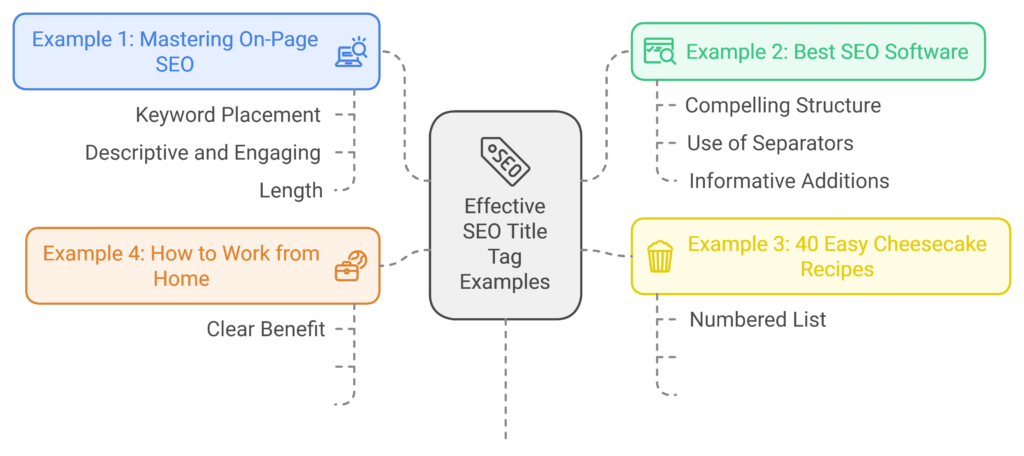
These examples demonstrate how effective title tags can significantly impact search engine visibility and click-through rates. By incorporating relevant keywords, maintaining clarity, and using engaging language or structures, businesses can optimize their title tags to attract more visitors and improve their overall SEO performance.

